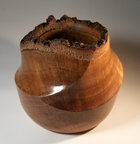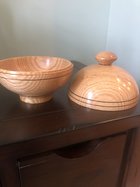Hi
Not sure if I just made a bad choice of finish, or if I’m doing something wrong?
Made a bowl out of red oak. Normally I use shellac with nice gloss, but I wanted this one to have a more durable and low luster finish.
I sanded to 600 grit, and then gave it 3 coats of watco danish oil 24 hours apart. Each coat was allowed to soak in for 15 minutes before wiping off.
The finish I ended up with is almost dead flat. No more gloss than just bare wood.
Would more coats give it more sheen? Did I do something wrong, or is that just what danish oil looks like?
Not sure if I just made a bad choice of finish, or if I’m doing something wrong?
Made a bowl out of red oak. Normally I use shellac with nice gloss, but I wanted this one to have a more durable and low luster finish.
I sanded to 600 grit, and then gave it 3 coats of watco danish oil 24 hours apart. Each coat was allowed to soak in for 15 minutes before wiping off.
The finish I ended up with is almost dead flat. No more gloss than just bare wood.
Would more coats give it more sheen? Did I do something wrong, or is that just what danish oil looks like?



